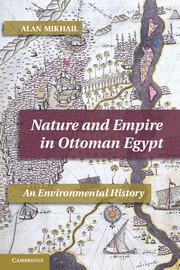Book contents
- Frontmatter
- Contents
- Maps
- Figures
- Tables
- Note on Transliteration and Dates
- Abbreviations
- Acknowledgments
- Map 1 Egypt and the Ottoman Empire
- Map 2 Lower Egypt (Nile Delta)
- Map 3 Middle Egypt
- Map 4 Upper Egypt
- Map 5 Cairo and Surroundings, 1801
- Introduction: Empire by Nature
- 1 Watering the Earth
- 2 The Food Chain
- 3 The Framework of Empire
- 4 In Working Order
- 5 From Nature to Disease
- 6 Another Nile
- Conclusion: The Imagination and Reality of Public Works
- Appendix: Citations for Cases Included in Tables 2.1–2.4
- Bibliography
- Index
- Titles in the series
3 - The Framework of Empire
Published online by Cambridge University Press: 03 May 2011
- Frontmatter
- Contents
- Maps
- Figures
- Tables
- Note on Transliteration and Dates
- Abbreviations
- Acknowledgments
- Map 1 Egypt and the Ottoman Empire
- Map 2 Lower Egypt (Nile Delta)
- Map 3 Middle Egypt
- Map 4 Upper Egypt
- Map 5 Cairo and Surroundings, 1801
- Introduction: Empire by Nature
- 1 Watering the Earth
- 2 The Food Chain
- 3 The Framework of Empire
- 4 In Working Order
- 5 From Nature to Disease
- 6 Another Nile
- Conclusion: The Imagination and Reality of Public Works
- Appendix: Citations for Cases Included in Tables 2.1–2.4
- Bibliography
- Index
- Titles in the series
Summary
Despite being everywhere in the province, wood was a very scarce natural resource in Egypt. It came from elsewhere to be shaped into chests and decorations, to be used in constructing homes and mosques, to build Egypt's rural irrigation network, and to make ships to move Egypt's food supplies. Wood was strong; relatively easy to work; and – because of these factors and its relative dearth in Egypt – eventually very expensive. As with the case of food in the previous chapter, the story of wood in eighteenth-century Ottoman Egypt is really the story of a system of Ottoman imperial connections that – as we will see in this chapter – functioned to bring wood to Egypt. Because Egypt did not have large indigenous forests, it relied on the wider Empire of which it was an integral part to supply the province with the wood it needed. Thus, the natural resource management problem facing Egypt and the Ottoman imperial system with which it was inextricably linked was how to balance a dearth of wood and massive amounts of grains in such a way that there were sufficient amounts of both goods in Egypt and across the Empire.
This linking of grain and wood followed the principle of comparative advantage. Egypt was an overly productive source of grain; sections of Anatolia and the Levant had large supplies of timber.
- Type
- Chapter
- Information
- Nature and Empire in Ottoman EgyptAn Environmental History, pp. 124 - 169Publisher: Cambridge University PressPrint publication year: 2011

